Condenser ultrasound microphone
Avisoft-Bioacoustics CM16/CMPA
Externally polarized condenser microphone for UltraSoundGate xx16x
part #40011
- Frequency range : 2 kHz – 200 kHz
- Approximate input-referred self-noise Level (bandwidth: 30-50 kHz) : 18 dB SPL
- Approximate sensitivity : 500 mV/Pa
- Power supply: 5 V, 16 mA (provided by the UltraSoundGate base unit)
- Connector: male XLR-5 plug
- Removeable protection grid
- Dimensions : 36 x 36 x 60 mm
- Weight : 65 g
- Supplied accessories : 5 m XLR-5 extension cable (other lengths of up to 300 m are available on request), high-quality Sennheiser microphone clamp and mini tripod
- Optionally available USB-powered microphone heating
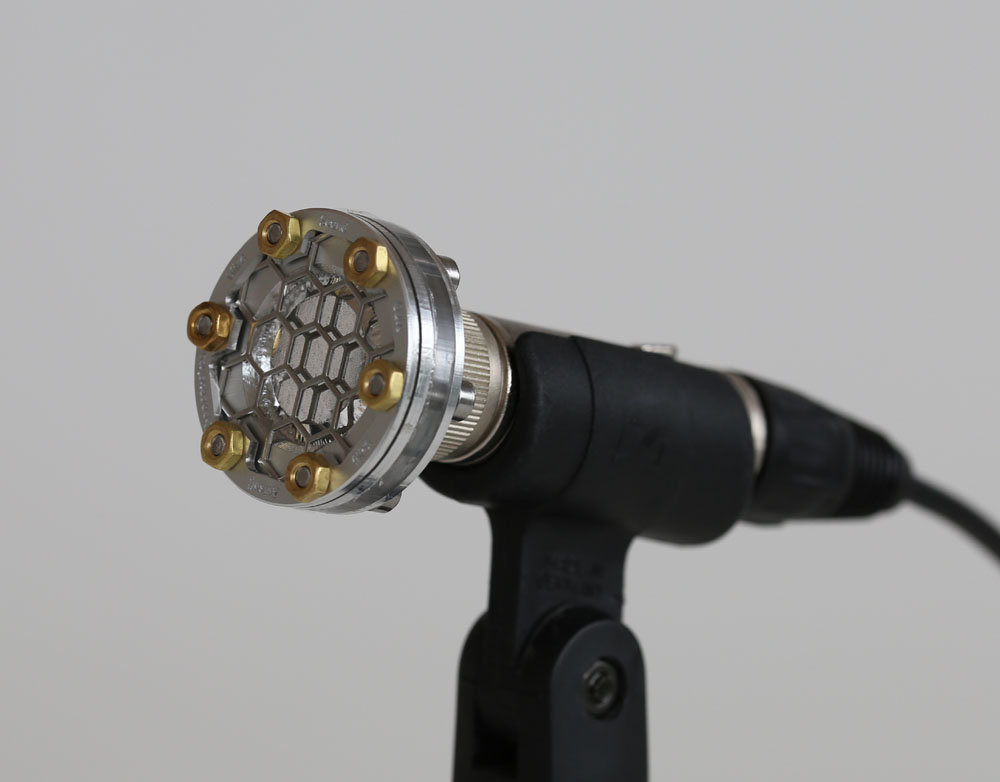
The condenser microphone Avisoft Bioacoustics CM16/CMPA provides a good compromise between sensitivity and flatness of the frequency response. It consists of an (replaceable) externally polarized metalized film diaphragm and a metal back plate. This microphone model requires an additional 200V polarization voltage that is supplied by the UltraSoundGate base units. An optional USB-powered heating module can prevent condensation when the microphone is being used in the field.
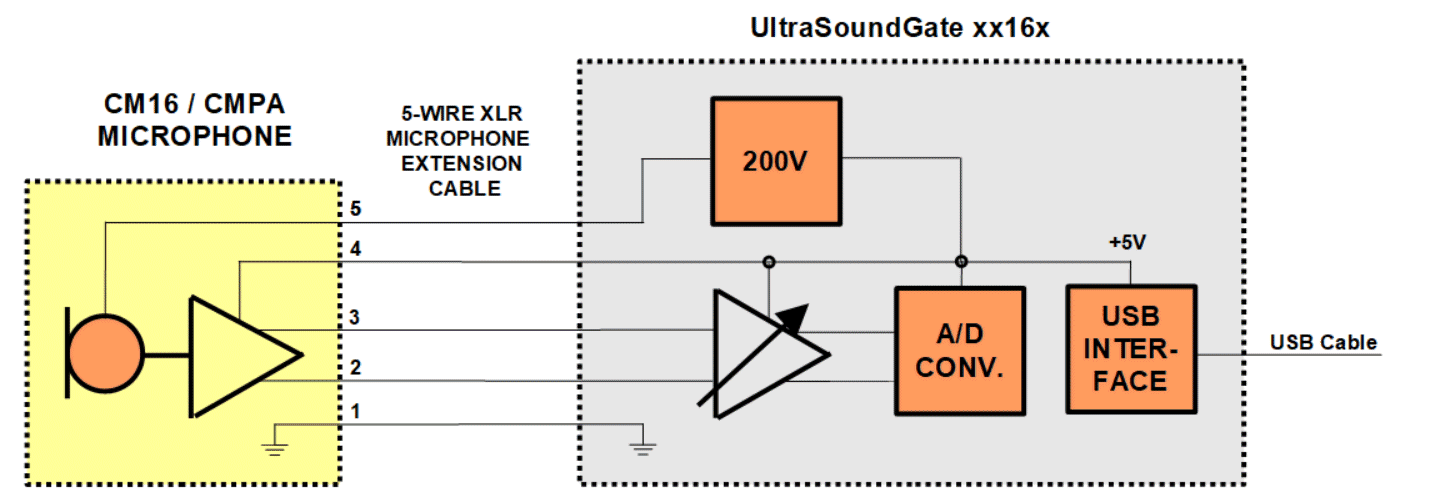
functional principle
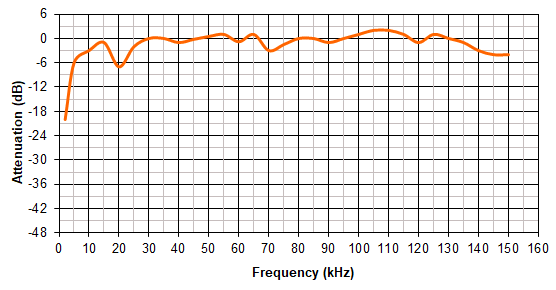
frequency response
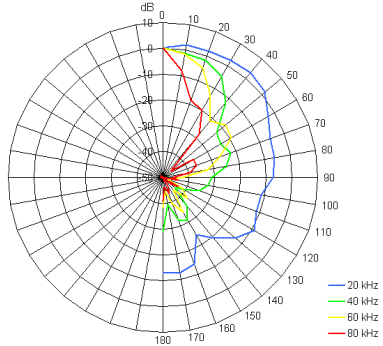
polar diagram
Condenser ultrasound microphone Avisoft-Bioacoustics CM16/CMPA-P48
with polarization voltage generator for third-party recording equipment that can supply a 48V (10mA) phantom power, such as computer audio interfaces or field recorders.
part # 40012
- Frequency range : 2 kHz – 200 kHz
- Approximate input-referred self-noise Level (bandwidth: 30-50 kHz): 18 dB SPL
- Power supply: 48V, 10mA phantom power
- Approximate sensitivity: 500mV/Pa
- Maximum differential output voltage swing: +-5V
- Connector: common male XLR-3 socket
- Removeable protection grid
- Dimensions : 36 x 36 x 125 mm
- Weight : 150 g
- Supplied accessories: two extension cables (5 m XLR-5 and 2 m XLR-3), high-quality Sennheiser microphone clamp, mini tripod and transport box
- Optionally available USB-powered microphone heating
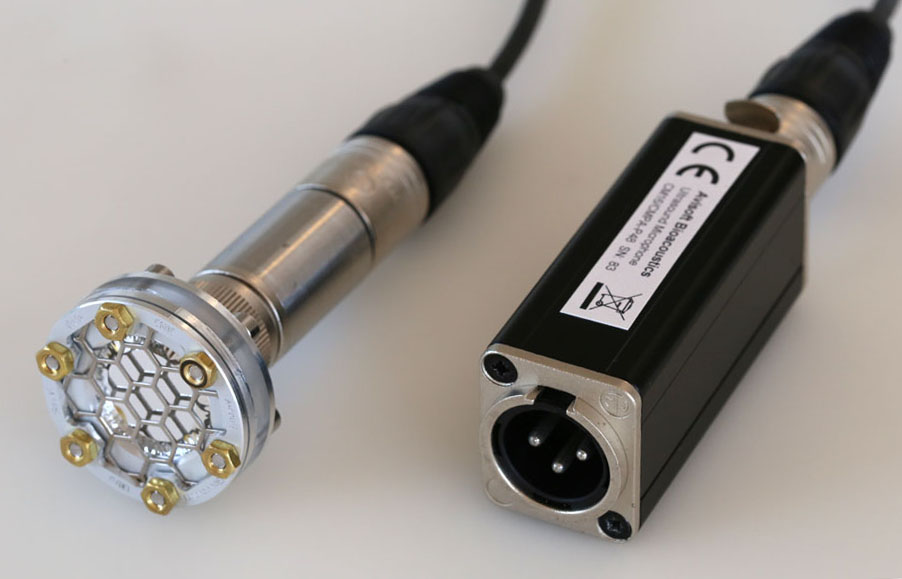
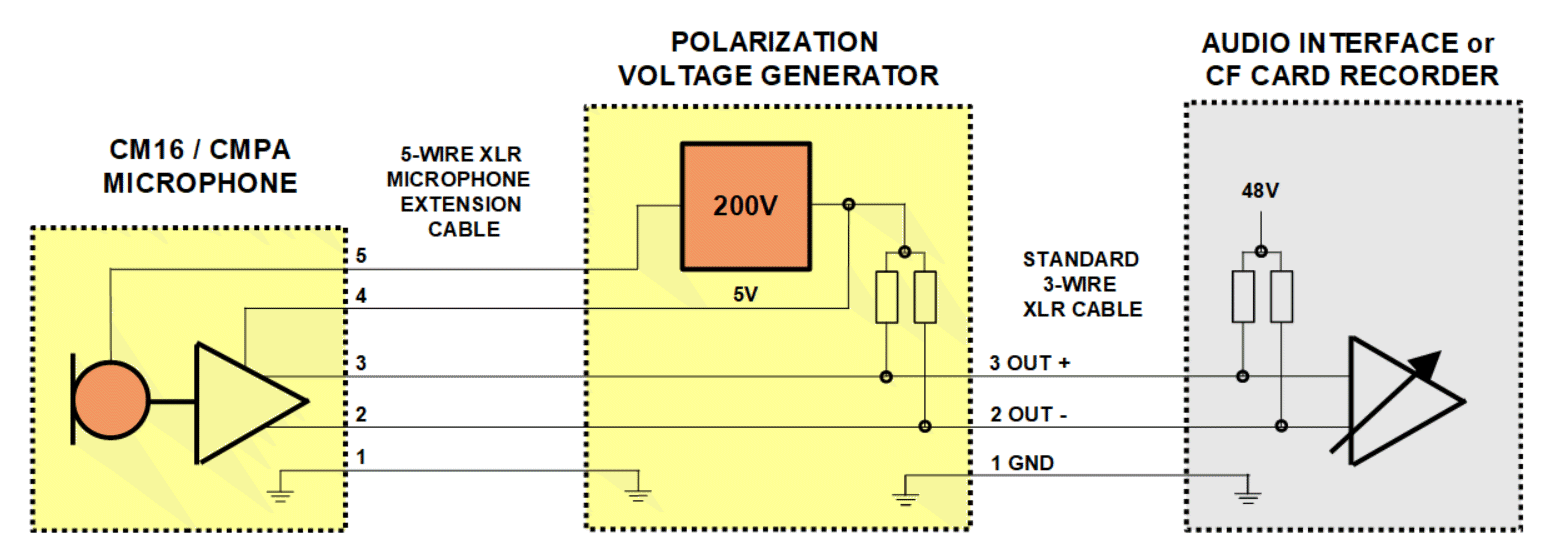
functional principle
Condenser ultrasound microphone Avisoft-Bioacoustics CM16/CMPA-5V
with polarization voltage generator for third-party recording equipment that can supply a 5V power supply voltage (15mA) *
part # 40013
- Frequency range : 2 kHz – 200 kHz
- Approximate input-referred self-noise Level (bandwidth: 30-50 kHz): 18 dB SPL
- Power supply: 5V, 17mA (must be supplied externally)
- Approximate sensitivity: 500mV/Pa
- Maximum differential output voltage swing: +-5V
- Connector: male XLR-4 socket
- Removeable protection grid
- Dimensions : 36 x 36 x 125 mm
- Weight : 150 g
- Supplied accessories: two extension cables (5 m XLR microphone cable and 1 m BNC signal output / USB power supply cable), high-quality Sennheiser microphone clamp, mini tripod and transport box
- On request, this microphone can be supplied with a 4-wire breakout cable for connecting to a screw terminal (instead of the standard BNC output / USB power supply cable).
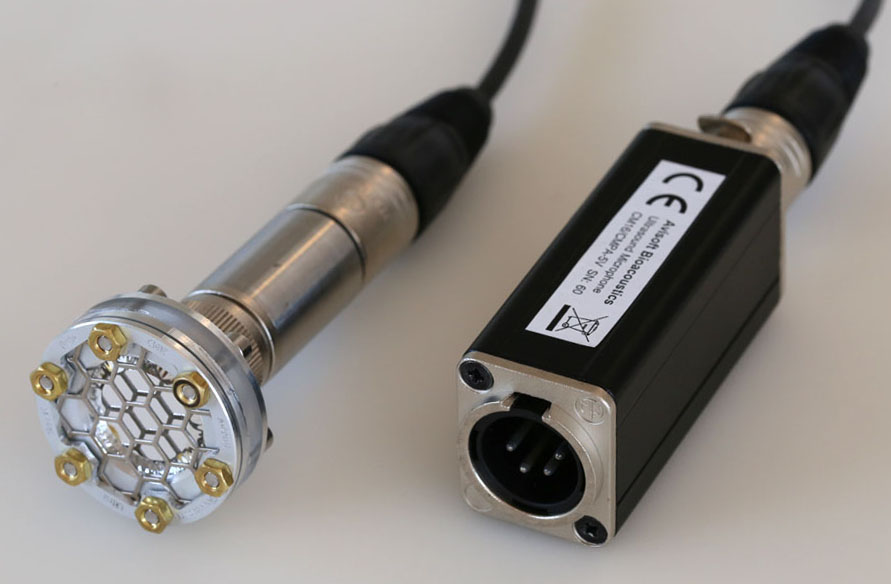

functional principle
Condenser ultrasound microphone Avisoft-Bioacoustics CM16/CMPA40-5V
with polarization voltage generator and adjustable 40dB preamplifier for third-party recording equipment that can supply a 5V (30mA) power supply voltage, such as National Instruments DAQ devices *
part # 40014
- Frequency range : 2 kHz – 200 kHz
- Approximate input-referred self-noise Level (bandwidth: 30-50 kHz): 18 dB SPL
- Power supply: 5V, 26mA (must be supplied externally)
- Approximate sensitivity: 1.4V/Pa … 140V/Pa
- Maximum differential output voltage swing: +-5V
- Output impedance: 1.0 kohm
- Connector: male XLR-4 socket
- Removeable protection grid
- Dimensions : 36 x 36 x 125 mm
- Weight : 150 g
- Supplied accessories: two extension cables (5 m XLR microphone cable and 1 m BNC signal output / USB power supply cable), high-quality Sennheiser microphone clamp, mini tripod and transport box
- On request, this microphone can be supplied with a 4-wire breakout cable for connecting to a screw terminal (instead of the standard BNC output / USB power supply cable).
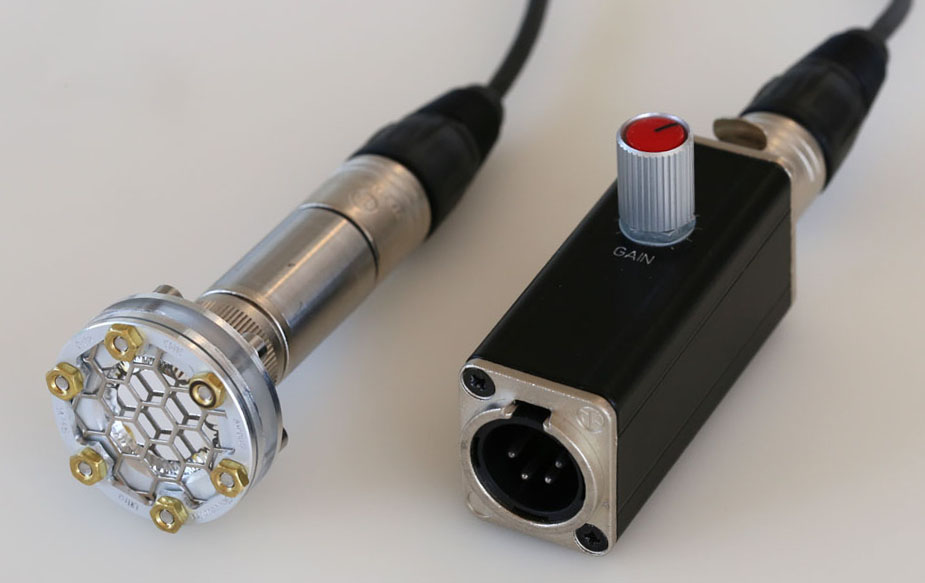

functional principle
Condenser ultrasound microphone Avisoft-Bioacoustics CM16/CMPA48AAF-5V
with polarization voltage generator and adjustable 48dB preamplifier and adjustable anti-aliasing filter for third-party recording equipment that can supply a 5V (50mA) power supply voltage, such as National Instruments DAQ devices
part # 40026
- Frequency range : 2 kHz – 200 kHz
- Approximate input-referred self-noise Level (bandwidth: 30-50 kHz): 18 dB SPL
- Power supply: 5V, 60mA (must be supplied externally)
- Approximate sensitivity: 250mV/Pa … 60V/Pa (step-wise adjustable gain between 0 and 48 dB)
- Integrated 16th order anti-aliasing filter, whose cut-off frequency can be set to 10, 20, 30, … 150 kHz
- Max output voltage swing: +-2.5 V
- Output impedance: 1.0 kohm
- Connector: male XLR-4 socket
- Removeable protection grid
- Dimensions : 36 x 36 x 125 mm
- Weight : 150 g
- Supplied accessories: two extension cables (5 m XLR microphone cable and 1 m BNC signal output / USB power supply cable), high-quality Sennheiser microphone clamp, mini tripod and transport box
- On request, this microphone can be supplied with a 4-wire breakout cable for connecting to a screw terminal (instead of the standard BNC output / USB power supply cable).
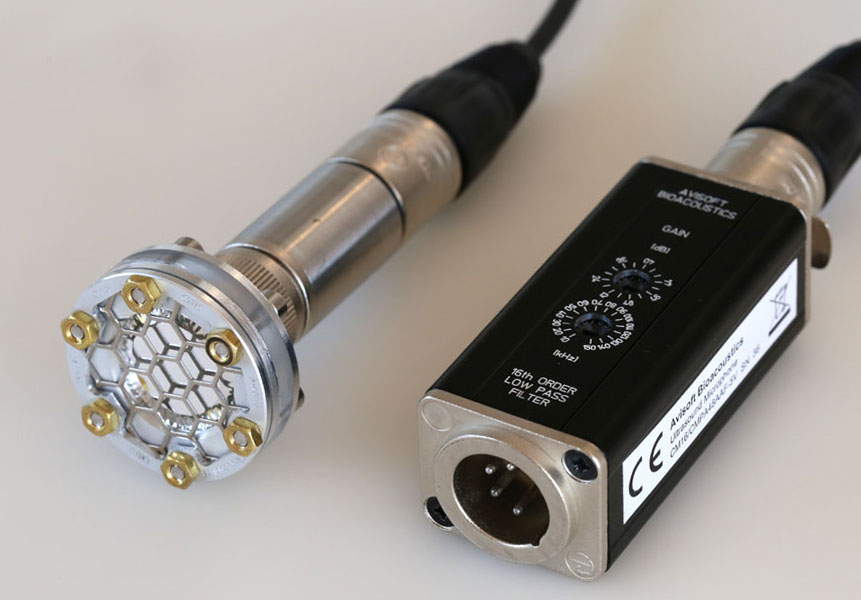

functional principle
* The E-, M- and X-series NI DAQ devices and other budget data acquisition systems do not include an anti-aliasing filter. However, the lack of such a filter can seriously degrade the overall signal-to-noise ratio of the recording system because noise components at frequencies above the nyquist frequency will be folded down to lower frequencies. For best results, it is therefore recommended to use an additional anti-aliasing filter (part#40026) or one of the UltraSoundGate xx16x devices that come with an integrated adaptive AAF.
Setting up an (ultrasound) recording system with third-party DAQ devices such as National Instruments units is not always simple because there are many potential pitfalls. We therefore recommend to use the integrated UltraSoundGate systems instead.
